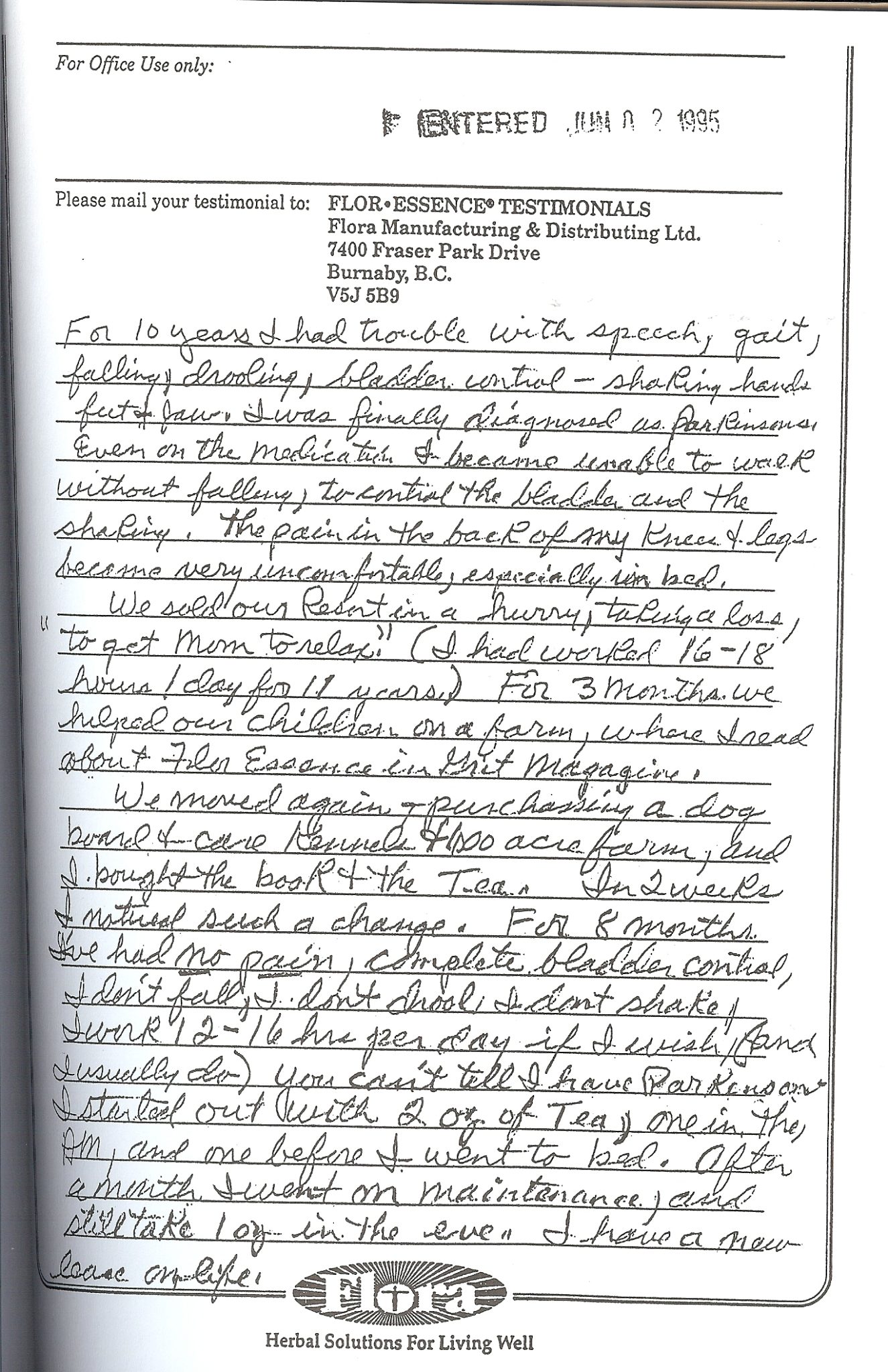
Could we have a Parkinson’s cure already? Recently, I came across some information on an old Ojibwa Indian remedy that acts as a detoxifier to eliminate toxins in one’s body. This Indian Remedy is so effective that you can read more about it in the Essiac Report. This report documents evidence that seems to prove the healing of multiple conditions, one of which is Parkinson’s. It is also said to eliminate or detoxify the body from toxins that cause cancer, diabetes, Psoriasis, Asthma, allergies, Alzheimer’s, ulcers, malignancies, sleeping disorders, MS, arthritis, Chronic Fatigue Syndrome and more! Above is a letter of someone who had Parkinson’s that writes about their changes.
See the video on Essiac here:
Listed below is research on Parkinson’s. Very interesting is their finding regarding antioxidants which fight free radicals and oxidation, which causes damage or death to cells:
-
- New research has identified a biological ‘trigger’ for Parkinson’s disease according to a recent news article. “Using both human neurons and fruit flies, researchers at Johns Hopkins have identified a protein, s15, that triggers a common form of Parkinson’s disease. The protein is enabled by an enzyme – leucine-rich repeat kinase 2 (LRRK2) – which then causes neurodegeneration. The study’s findings suggest that inhibiting s15 and LRRK2 could prevent the loss of dopamine neurons and the onset of Parkinson’s disease. ”
-
- New studies also suggests the alpha-synuclein (AS) gene may have something to do with Parkinson’s. This AS gene releases dopamine which controls voluntary and involuntary movement. People with Parkinson’s typically have low levels of dopamine.
-
- In this study entitled, Combined R-alpha-lipoic acid and acetyl-L-carnitine exerts efficient preventative effects in a cellular model of Parkinson’s disease, it said that the study provided evidence that combining mitochondrial antioxidants (nutrients), specifically Alpha Lipoic Acid and Acetyl-L-Carnitine at optimal doses may be quite effective against Parkinson’s and prevention.
-
- In this study researchers found that, “When 5-HTP and L-dopa are administered in proper balance along with L-tyrosine, L-cysteine, and cofactors under the guidance of OCT assay interpretation, the long list of problems that can interfere with optimum administration of L-dopa becomes controllable and manageable or does not occur at all. Patient treatment then becomes more effective by allowing the implementation of the optimal dosing levels of L-dopa needed for the relief of symptoms without the dosing value barriers imposed by side effects and adverse reactions seen in the past.”
-
- And in yet another study…A Harvard Medical School study followed 50,000 men for 20 years. Researchers found that men who ate the most blueberries lowered their risk for Parkinson’s disease by 40 percent. The men who ate just one serving of blueberries a week reduced their risk by 25 percent. Blueberries are rich in anthocyanin which is an antioxidant that can help prevent oxidative stress and fight free radicals. This antioxidant helps lower blood pressure and fights heart disease as well.
-
- In 2006, researchers at Purdue University discovered that a drug used to treat tuberculosis called Sodium Para-Aminosalicylic Acid or PAS cured patients of Parkinson’s-like symptoms suffered by mineworkers, welders and others exposed to high levels of the metal manganese. Those exposed to high levels of manganese are said to suffer from slow oxidation, a sympathetic dominance or the inability to eliminate toxic metals from one’s body. According to Wei Zheng, a professor and University Faculty Scholar at Purdue’s School of Health Sciences said, “Manganese builds up in toxic levels in the body and people suffer from occupational manganese parkinsonism, which causes symptoms similar to Parkinson’s disease. Manganese is a pro-inflammatory mineral, so removing it would reduce the tendency for inflammation in the brain. Patients who have too much manganese can experience hand tremors, poor coordination, an unsteady gait and an inability to show facial expressions. See the official study here. Researchers from around the world, including Purdue University conducted a 17-year medical follow-up study on a manganese-poisoned worker and 80 other patients. The researchers learned Sodium Para-Aminosalicylic Acid dramatically reduced these symptoms for the long-term. Zheng said, “The amazing thing is that this drug reverses Parkinson-type symptoms created by manganese intoxication. We see remarkable improvement after treatment with this drug even 17 years later.” PAS has been used for decades to treat tuberculosis and it can cross the blood-brain barrier and penetrate the membranes because it is fat-soluble.
-
- Sound Therapy has been successful for some. See my post here. Portable Sound Stimulator being tested on Parkinson’s patients.
-
- Parkinson’s and riding a bike can be VERY beneficial as well as you can see here.
- According to Dr. Lawrence Wilson, in his book Nutritional Balancing and Hair Mineral Analysis, some one who eliminates toxins poorly can be defined with the following criteria:
- Aluminum – 0.3 to 0.64 mg%
- Lead – 0.01 to 0.029 mg%
- Mercury – 0.01 to 0.031 mg%
- Cadmium – 0.002 to 0.004 mg%
- Arsenic – .002 to 0.004 mg%
- Nickel – 0.01 to 0.03mg%
- Iron – 0.7 to 1.19 mg%
- Manganese – 0.009 to 0.02 mg%
- Copper – 1.0 to 1.4 mg% in a slow oxidizer
- Copper – 0.9 to 1.4 in a fast oxidizer. This is newer and still being researched.
- Boron – 0.02 to 0.04 mg%. (Note: boron is still being researched. It is not currently read on hair charts from Analytical Research Labs and may be less important.)
- Vanadium – 0.1 to 0.2 mg%. (Note: vanadium is still being researched and is not currently read on Analytical Research Labs charts, and may be is less important.)
Very poor eliminator pattern criteria:
- Aluminum – less than about 0.3 mg%
- Lead – less than about 0.01 mg%
- Mercury – less than about 0.01 mg%
- Cadmium – less and 0.002 mg%
- Arsenic – less than about 0.002 mg%
- Nickel – less than about 0.01 mg%
- Iron – less than about 0.7 mg%
- Manganese – less than about 0.009 mg%
- Copper – less than 1.0 mg% in a slow oxidizer.
- Copper – less than about 0.9 in a fast oxidizer.
- Boron – less than 0.02 mg%
- Vanadium – less than 0.1 mg%
There is so much to know and understand about Parkinson’s Disease. To learn about Dr. Wilson’s suggestions for a detox regime, click here. For a hair analysis kit, go here.
♦An interesting and quite unusual product for detoxification is Willard’s Water. This is not your standard product and if you look at my blog post here, you’ll know why. Willard Water is not a nutrient, but a catalyst or vehicle by which nutrients are carried throughout the body’s cells, and by which waste is carried away from the cells with water as a means of transportation. In other words, for those who need to detoxify, this water may be an option. Back in the 1980s, 60 Minutes did a special on this water and what you’ll learn is very interesting. Willard’s Water has been prohibited by the FDA to tout any remedies, but many people use it. (See Disclaimer)


Leave a Reply